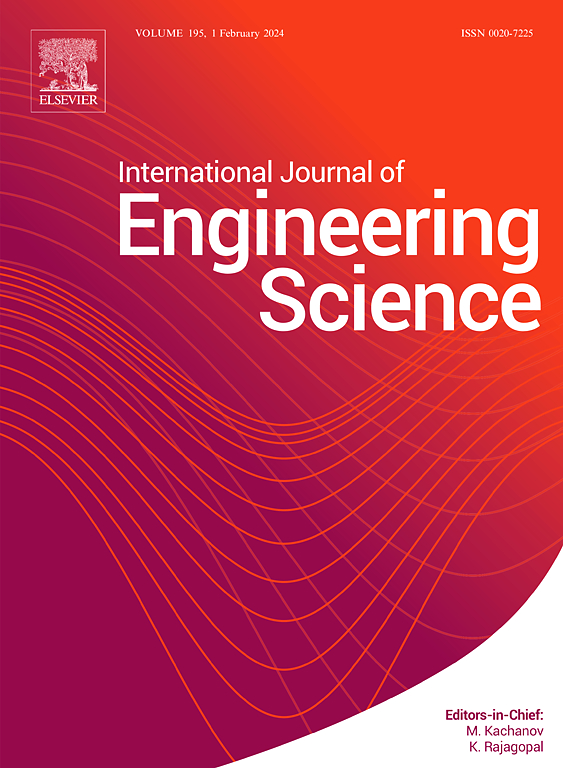循环荷载作用下非线性压缩特性的时域粘弹性模型
IF 5.7
1区 工程技术
Q1 ENGINEERING, MULTIDISCIPLINARY
International Journal of Engineering Science
Pub Date : 2024-12-19
DOI:10.1016/j.ijengsci.2024.104200
引用次数: 0
摘要
粘弹性(VE)衬垫通常用作阻尼装置中的被动阻尼元件来吸收和耗散能量,但由于显著的非线性,在预测大变形下的力学行为方面存在挑战。本研究引入了一种新的非线性时域模型,以准确表征VE衬垫在小、中、大压缩变形循环加载下的响应。应变硬化、穆林效应、连续应力软化和残余变形等效应被纳入模型。所提出的模型集成了超弹性、粘弹性和弹塑性部件,它们平行排列,每个部件都处理力学行为的不同方面。超弹性部分捕获时间无关的响应,特别是非线性刚度中的应变硬化。VE部分解释了频率相关的阻尼行为,侧重于初始卸载刚度、滞回线的形状和面积以及主要残余变形。弹塑性部件模拟频率相关塑性,调节残余变形,确定Mullins效应和连续应力软化的程度。模型参数通过拟合程序确定,使用单轴准静态和循环压缩试验数据,允许在时域内准确描述非线性力学行为。为了评估模型的预测能力和适用性,通过误差分析对仿真结果进行了比较评价。进一步进行敏感性分析,考察各参数的影响。所提出的模型在表示VE垫块在小、中、大压缩变形中的力学行为方面具有较高的准确性和鲁棒性。超弹性、粘弹性和弹塑性部件中的参数具有准确的解释,对整体力学行为具有不同的作用和贡献。本文章由计算机程序翻译,如有差异,请以英文原文为准。
A time-domain viscoelastic model of nonlinear compression behavior under cyclic loading
Viscoelastic (VE) pads, commonly employed as passive damping components in damping devices to absorb and dissipate energy, present challenges in predicting the mechanical behavior under large deformation due to significant nonlinearity. This study introduces a novel nonlinear time-domain model to accurately characterize the response of VE pads subjected to cyclic loading across small, moderate, and large compressive deformations. Effects such as strain hardening, the Mullins effect, continuous stress softening, and residual deformation are incorporated into the model. The proposed model integrates hyperelastic, viscoelastic, and elastoplastic parts, arranged in parallel, each addressing distinct aspects of the mechanical behavior. The hyperelastic part captures the time-independent response, in particular strain hardening in nonlinear stiffness. The VE part accounts for the frequency-dependent damping behavior, focusing on the initial unloading stiffness, the shape and area of the hysteresis loop, and major residual deformations. The elastoplastic part models the frequency-dependent plasticity, adjusting residual deformation and determining the extent of Mullins effect and continuous stress softening. Model parameters are determined through fitting procedures using uniaxial quasi-static and cyclic compression test data, allowing for an accurate description of the nonlinear mechanical behavior in the time domain. To assess the prediction capacity and applicability of the proposed model, the simulation results are comparatively evaluated by error analysis. The sensitivity analysis is further performed to investigate the influence of individual parameters. The proposed model demonstrates high accuracy and robustness in representing the mechanical behavior of VE pads across small, moderate, and large compressive deformations. The parameters in the hyperelastic, viscoelastic, and elastoplastic parts have accurate interpretations, providing distinct roles and contributions to the overall mechanical behavior.
求助全文
通过发布文献求助,成功后即可免费获取论文全文。
去求助
来源期刊

International Journal of Engineering Science
工程技术-工程:综合
CiteScore
11.80
自引率
16.70%
发文量
86
审稿时长
45 days
期刊介绍:
The International Journal of Engineering Science is not limited to a specific aspect of science and engineering but is instead devoted to a wide range of subfields in the engineering sciences. While it encourages a broad spectrum of contribution in the engineering sciences, its core interest lies in issues concerning material modeling and response. Articles of interdisciplinary nature are particularly welcome.
The primary goal of the new editors is to maintain high quality of publications. There will be a commitment to expediting the time taken for the publication of the papers. The articles that are sent for reviews will have names of the authors deleted with a view towards enhancing the objectivity and fairness of the review process.
Articles that are devoted to the purely mathematical aspects without a discussion of the physical implications of the results or the consideration of specific examples are discouraged. Articles concerning material science should not be limited merely to a description and recording of observations but should contain theoretical or quantitative discussion of the results.
 求助内容:
求助内容: 应助结果提醒方式:
应助结果提醒方式:


